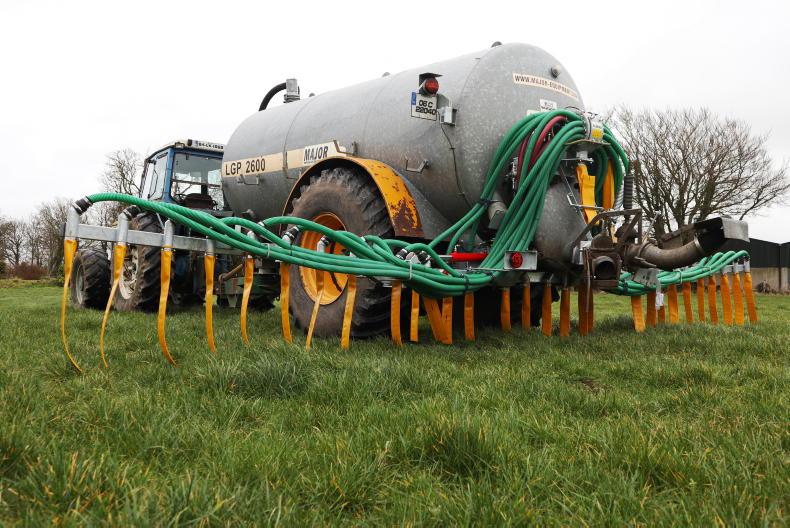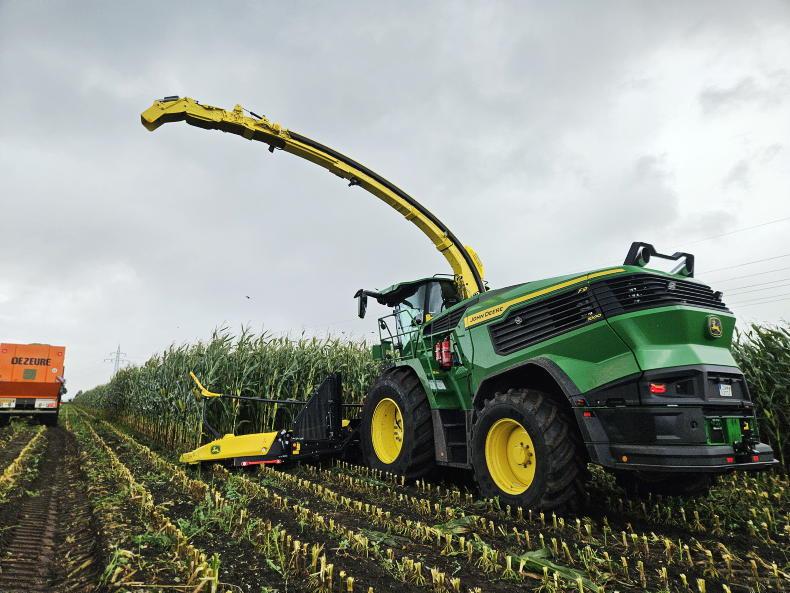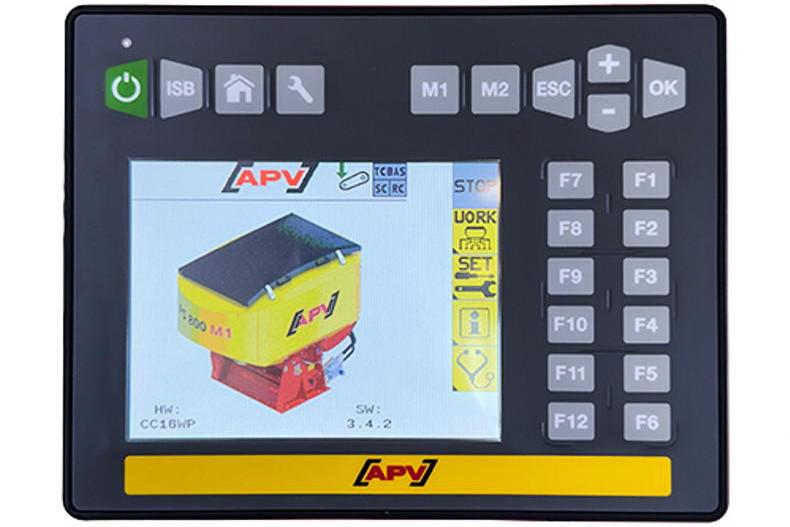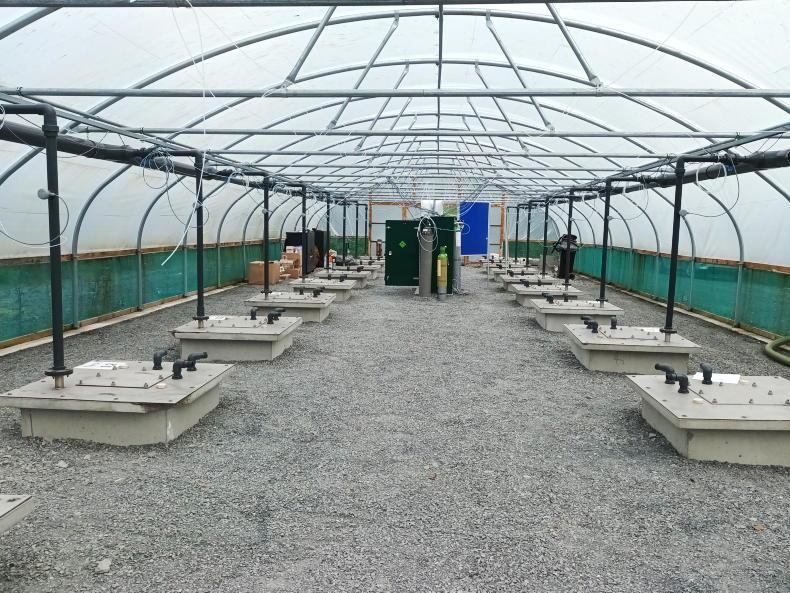Based near Kilmallock in Co Limerick, Pat Hughes is an agricultural contractor with a passion for engineering.
Almost a decade ago, Pat observed the major shift to umbilical slurry spreading systems due to difficult ground conditions after periods of harsh weather. He felt he needed to offer the service to his customers.
The week before Christmas 2012, Pat started manufacturing his own complete system including reelers and a splash plate unit. This first unit was for his own use, and is still in use today.
As time moved on, local contractors noted his craftsmanship and began asking him to build units. From then on, Pat began supplying a small numbers of systems.

A typical 8m dribble bar Pat manufactures has 30 outlets with 275mm spacings.
“During the winter, like many contractors, we traditionally had a quiet period in the lead up to Christmas. Just before the Christmas of 2012, the constant wet weather looked like it was going to lead to a consecutive difficult slurry campaign for tankers. As a result, my son Paddy and I decided to make our own umbilical system,” explains Pat.
In the years that followed, the shift towards low-emission slurry systems began to gain a foothold and Pat turned his hand to manufacturing dribble bars in 2016.
He adds: “With LESS equipment becoming compulsory for many farmers, it’s meant we have been getting busier and busier in the last few years. Up to now we have been managing the contracting and fabricating hand in hand, but soon we will need to dedicate staff solely to the fabricating side of our business.”

Once folded up in the transport position, gravity will force the top one metre of the dribble bar each side to fall in towards the centre of the tanker.
Fabrication
Pat was never a stranger to steel fabrication, having carried some local engineering works mainly on hedge cutters and saw heads back in the early 1990s. However, the contracting business was growing and Pat dedicated his time to the hire work. Today, the engineering business trades under the name Newtown Engineering.
The steel cutting is subbed out to a local engineering firm where it is cut using a plasma cutter, while the rest of the manufacturing process such as the welding, assembly and retro-fitting takes place in-house. Pat, his son Paddy, his partner Caroline and some other staff help out with the manufacturing process.
The dribble bars feature a double spring break-back system which is hinged at the folding point.
Dribble bars
The first notable design Pat uses is mounting the dribble bar on to the tanker’s chassis, instead of on to the back door. “The back door on a tanker is the hardest part to seal. I believe mounting the dribble bar to a chassis is the safest and most stable option. As every brand of a tanker varies slightly, we like to take the customer’s tanker into our workshop and fit the dribble bar to our standard. With varying brands of tankers on the market, we find there is no one-size-fits-all solution,” explains Pat.
Although he started off using Vogelsang macerators, he later switched to a Dutch-built vertical Alrena (Bomech) macerator based on feedback from contractors.
Just one spool
All functions on the firm’s dribble bar are controlled using just one spool valve. An electro control junction box is powered through the tractor’s three-pin plug. This powers a diverter switch mounted on the chosen spool valve handle. When the diverter switch is engaged and the spool is operated, it will raise and lower the dribble bar.
Meanwhile, when the spool is engaged without the diverter switch, it will engage/disengage the macerator. Pat says that the thinking behind this was that if the operator accidently caught the spool valve on the road or getting out of the tractor, the dribble bar would not lower. It was also designed for more basic-spec tractors where limited spool valves are available.
The electro-control junction box also has an on/off switch.
It’s well known that most macerator manufacturers will advise users to run the macerator in each direction every second load, and the Alrena is no different. This is because these macerators are designed to cut in both directions, so to get the most life out of them, even wearing of the double-sided blades is essential. The diverter valve to change the direction the macerator runs at is conveniently positioned beside the rear left fill point. Pat uses the Alrena V30 precision macerator which has a six-knife rotor on both sides (12 knives in total). This chops the material which is fed out through the 30 outlets with a diameter of 40mm. A typical 8m dribble bar Pat manufactures has 275mm spacings.
The V30 macerator features an auto-reverse valve. This means that if it gets blocked, it will automatically change direction and unblock itself. The macerator also features a stone trap which is located directly underneath.
For those looking to use the splash plate instead of the dribble bar, the same spool is used. It’s just a matter of turning a diverter valve which is positioned beside the gate valve, which completely disconnects all dribble bar functions. 
Pat is currently building 400m and 600m front reelers and 800m, 1,000m and 1,200m rear-mounted reelers.
Break-back system
The dribble bars feature a double spring break-back system which is hinged at the folding point. Once folded up in the transport position, gravity will force the top metre of the dribble bar each side to fall in towards the centre of the tanker. This allows the dribble bar to fold into a safer position for transport. The unit is folded to offer a transport width at the widest point of 2.3m.
For those after a dribble bar which can be used on either a tanker or an umbilical system, Pat has begun building a heavy duty A-frame design from 80x80 box section. All reelers and dribble bars are galvanised and fitted with LED lighting as standard.
The pins and linkages are fitted with grease points. At present, Pat is only offering 7.5m and 8m units, but has explained that he is currently working on a 10m and 12m design which should be available later this year. He is building 400m and 600m front reelers and 800m, 1,000m and 1,200m rear-mounted reelers.
When selling full umbilical systems, he couples them with Bauer pumps and Hilcroflex hosing.
Pat confirmed that his dribble bars are CE-certified and TAMS II grant-approved. Depending on the brackets required, his 8m dribble bar weighs in at approximately 600kg. However, the umbilical dribble bar will be heavier as it is reinforced to carry the additional weight of the reeler and hosing. An 8m dribble bar, including being retro-fitted to a tanker, is priced at €12,500 plus VAT.
Based near Kilmallock in Co Limerick, Pat Hughes is an agricultural contractor with a passion for engineering.
Almost a decade ago, Pat observed the major shift to umbilical slurry spreading systems due to difficult ground conditions after periods of harsh weather. He felt he needed to offer the service to his customers.
The week before Christmas 2012, Pat started manufacturing his own complete system including reelers and a splash plate unit. This first unit was for his own use, and is still in use today.
As time moved on, local contractors noted his craftsmanship and began asking him to build units. From then on, Pat began supplying a small numbers of systems.

A typical 8m dribble bar Pat manufactures has 30 outlets with 275mm spacings.
“During the winter, like many contractors, we traditionally had a quiet period in the lead up to Christmas. Just before the Christmas of 2012, the constant wet weather looked like it was going to lead to a consecutive difficult slurry campaign for tankers. As a result, my son Paddy and I decided to make our own umbilical system,” explains Pat.
In the years that followed, the shift towards low-emission slurry systems began to gain a foothold and Pat turned his hand to manufacturing dribble bars in 2016.
He adds: “With LESS equipment becoming compulsory for many farmers, it’s meant we have been getting busier and busier in the last few years. Up to now we have been managing the contracting and fabricating hand in hand, but soon we will need to dedicate staff solely to the fabricating side of our business.”

Once folded up in the transport position, gravity will force the top one metre of the dribble bar each side to fall in towards the centre of the tanker.
Fabrication
Pat was never a stranger to steel fabrication, having carried some local engineering works mainly on hedge cutters and saw heads back in the early 1990s. However, the contracting business was growing and Pat dedicated his time to the hire work. Today, the engineering business trades under the name Newtown Engineering.
The steel cutting is subbed out to a local engineering firm where it is cut using a plasma cutter, while the rest of the manufacturing process such as the welding, assembly and retro-fitting takes place in-house. Pat, his son Paddy, his partner Caroline and some other staff help out with the manufacturing process.
The dribble bars feature a double spring break-back system which is hinged at the folding point.
Dribble bars
The first notable design Pat uses is mounting the dribble bar on to the tanker’s chassis, instead of on to the back door. “The back door on a tanker is the hardest part to seal. I believe mounting the dribble bar to a chassis is the safest and most stable option. As every brand of a tanker varies slightly, we like to take the customer’s tanker into our workshop and fit the dribble bar to our standard. With varying brands of tankers on the market, we find there is no one-size-fits-all solution,” explains Pat.
Although he started off using Vogelsang macerators, he later switched to a Dutch-built vertical Alrena (Bomech) macerator based on feedback from contractors.
Just one spool
All functions on the firm’s dribble bar are controlled using just one spool valve. An electro control junction box is powered through the tractor’s three-pin plug. This powers a diverter switch mounted on the chosen spool valve handle. When the diverter switch is engaged and the spool is operated, it will raise and lower the dribble bar.
Meanwhile, when the spool is engaged without the diverter switch, it will engage/disengage the macerator. Pat says that the thinking behind this was that if the operator accidently caught the spool valve on the road or getting out of the tractor, the dribble bar would not lower. It was also designed for more basic-spec tractors where limited spool valves are available.
The electro-control junction box also has an on/off switch.
It’s well known that most macerator manufacturers will advise users to run the macerator in each direction every second load, and the Alrena is no different. This is because these macerators are designed to cut in both directions, so to get the most life out of them, even wearing of the double-sided blades is essential. The diverter valve to change the direction the macerator runs at is conveniently positioned beside the rear left fill point. Pat uses the Alrena V30 precision macerator which has a six-knife rotor on both sides (12 knives in total). This chops the material which is fed out through the 30 outlets with a diameter of 40mm. A typical 8m dribble bar Pat manufactures has 275mm spacings.
The V30 macerator features an auto-reverse valve. This means that if it gets blocked, it will automatically change direction and unblock itself. The macerator also features a stone trap which is located directly underneath.
For those looking to use the splash plate instead of the dribble bar, the same spool is used. It’s just a matter of turning a diverter valve which is positioned beside the gate valve, which completely disconnects all dribble bar functions. 
Pat is currently building 400m and 600m front reelers and 800m, 1,000m and 1,200m rear-mounted reelers.
Break-back system
The dribble bars feature a double spring break-back system which is hinged at the folding point. Once folded up in the transport position, gravity will force the top metre of the dribble bar each side to fall in towards the centre of the tanker. This allows the dribble bar to fold into a safer position for transport. The unit is folded to offer a transport width at the widest point of 2.3m.
For those after a dribble bar which can be used on either a tanker or an umbilical system, Pat has begun building a heavy duty A-frame design from 80x80 box section. All reelers and dribble bars are galvanised and fitted with LED lighting as standard.
The pins and linkages are fitted with grease points. At present, Pat is only offering 7.5m and 8m units, but has explained that he is currently working on a 10m and 12m design which should be available later this year. He is building 400m and 600m front reelers and 800m, 1,000m and 1,200m rear-mounted reelers.
When selling full umbilical systems, he couples them with Bauer pumps and Hilcroflex hosing.
Pat confirmed that his dribble bars are CE-certified and TAMS II grant-approved. Depending on the brackets required, his 8m dribble bar weighs in at approximately 600kg. However, the umbilical dribble bar will be heavier as it is reinforced to carry the additional weight of the reeler and hosing. An 8m dribble bar, including being retro-fitted to a tanker, is priced at €12,500 plus VAT.














SHARING OPTIONS